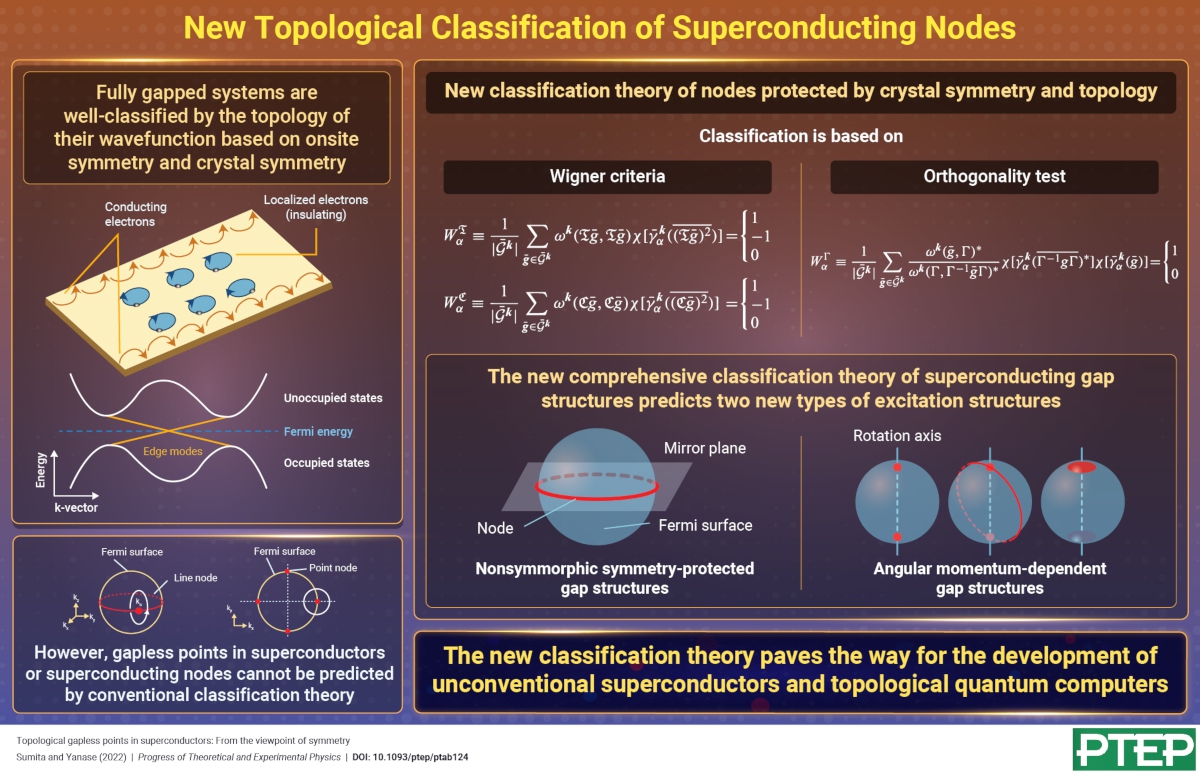New Classification Theory for Topological Gapless Superconducting Nodes
© The Physical Society of Japan
This article is on
Topological gapless points in superconductors: From the viewpoint of symmetry
(PTEP Editors' Choice)
Prog. Theor. Exp. Phys. https://doi.org/10.1093/ptep/ptab124.
A new classification theory on topological superconducting gap nodes predicts two new gap structures emerging from a nonsymmorphic crystal symmetry and angular momentum.

Topological phases of matter, such as topological insulators, semimetals, and superconductors, have garnered much attention in condensed matter physics. These are strange materials characterized by the presence of conduction states on the surface while the bulk remains insulating. Moreover, the surface states are protected by certain symmetries against physical deformations or defects.
It turns out that such systems can be classified by a “topological invariant” or a topological number such that two systems with the same topological number are equivalent. The topological invariant is classified by the symmetry and dimensionality of the system and is well-defined for gapped Hamiltonian systems. A well-known classification scheme is based on onsite symmetries, such as time-reversal symmetry, particle-hole symmetry, and chiral symmetry. However, recent schemes involve both crystal symmetry and onsite symmetry.
Interestingly, topological superconductors often have gapless points called “superconducting nodes” that are characterized by topological invariants, even though topology for the wavefunction can only be defined for gapped Hamiltonians. While there exist some classification theories for the superconducting order parameter predicting such nodes, they are sometimes incompatible with the actual superconducting gap structure and do not account for space group symmetry and higher-spin states.
In this paper, we present a new classification theory for superconducting nodes to resolve these two problems. We constructed this theory based on arguments from group theory and topology. An earlier topological classification theory focused on the d-dimensional Brillouin zone (BZ). However, since a band gap cannot exist in a whole d-dimensional BZ in nodal superconductors, we instead considered a p-dimensional (p < d) sphere surrounding nodes in the BZ.
We fixed a specific k point in the BZ and then developed the classification theory on the high-symmetry points using the Wigner criteria and the orthogonality test. Our results predicted two new types of excitation structures, i.e., unconventional superconducting nodes protected by crystal symmetry and topology.
By performing classification on high-symmetry planes, we predicted nontrivial gap structures appearing from nonsymmorphic space group symmetry, which can be decomposed into a product of non-primitive lattice translation and a point group operation. Meanwhile, performing classification on high-symmetry lines helped predict nontrivial gap structures dependent on the angular momentum of the normal Bloch state.
Because these classification structures are determined only by symmetry, they can be universally applied to many candidate superconductors, potentially leading to the discovery of superconductors hosting unconventional nodes.
Topological gapless points in superconductors: From the viewpoint of symmetry
(PTEP Editors' Choice)
Prog. Theor. Exp. Phys. https://doi.org/10.1093/ptep/ptab124.
Share this topic
Fields
Related Articles
-
A New Superconductor Family with Various Magnetic Elements
Superconductivity
Cross-disciplinary physics and related areas of science and technology
Electron states in condensed matter
2023-10-27
A new superconductor family, Sc6MTe2, has been discovered, comprising seven variations with magnetic elements labeled as M. Notably, only a few known superconductor families exist that involve various magnetic elements.
-
Exploring Vortex Dynamics in a Multi-band Superconductor
Superconductivity
2023-8-22
We measured the microwave flux-flow Hall effect in FeSe, where the cancellation of holes and electrons was observed. This is a novel effect of multi-band superconductors.
-
Double Superconductivity in Nodal Line Material NaAlSi; Coexistence of Bulk and 2D Superconductivities
Superconductivity
Electronic structure and electrical properties of surfaces and nanostructures
2023-7-26
Unique diamagnetic torque signals are found in the nodal line material NaAlSi, which suggests the presence of double superconductivity; i.e., bulk superconductivity and 2D superconductivity on the crystal surface.
-
Self-Energy Singularity Explains High-Temperature Superconductivity in Cuprates
Superconductivity
Electron states in condensed matter
2023-7-18
A new review discusses the high-temperature superconductivity mechanisms in copper oxides, explaining the various phases observed in these materials based on a nonperturbative effect called self-energy singularity.
-
Ultra Purification Unveils the Intrinsic Nature in Spin-Triplet Superconductor UTe2
Superconductivity
Magnetic properties in condensed matter
2023-7-5
Microscopic spin-susceptibility measurements in ultra-pure UTe2 samples reveal that superconducting symmetry is analogous to the superfluidity of the 3He B-phase and that U deficiency has a significant impact on superconducting properties.
